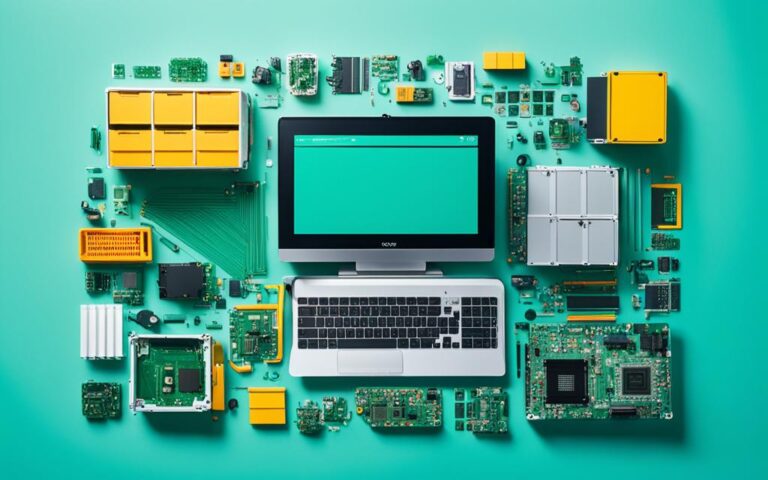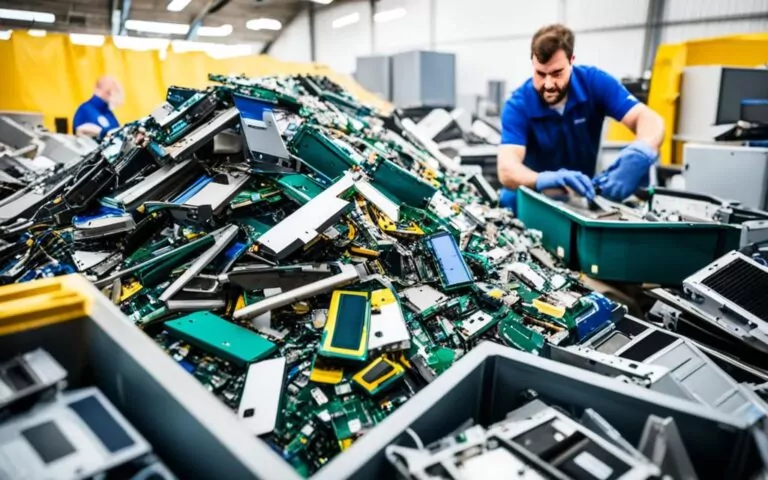The Environmental Impact of Zero-Waste Computer Processing
Green computing, also known as Green Technology or Green IT, aims to reduce the environmental impact of technology. It focuses on reducing energy consumption and promoting sustainability in the design, engineering, manufacturing, use, and disposal of computing devices. The use of computers contributes to CO2 emissions and energy wastage, making it crucial to adopt zero-waste processing innovation to minimize environmental impact.
What is Green Computing and Why is it Important?
Green computing involves using computers and their resources in an environmentally responsible manner. It aims to reduce the carbon footprint of the IT industry and promote sustainability. By implementing energy-efficient CPUs, servers, and peripherals, as well as reducing resource consumption and properly disposing of electronic waste, green computing helps to minimize the environmental impact of technology.
Green computing focuses on adopting practices that save energy, reduce electronic waste, and promote the efficient use of resources. These practices include:
- Using energy-efficient hardware components such as CPUs and servers that consume less power.
- Implementing power management techniques to reduce energy consumption, such as automatic sleep or shutdown modes when devices are not in use.
- Optimizing software and applications to run efficiently and minimize resource usage.
- Virtualization and cloud computing, which can consolidate computing resources and reduce energy consumption.
- Properly disposing of electronic waste by recycling or reusing components and materials.
Green computing is important because it addresses the significant environmental impact of technology. The IT industry is a major contributor to greenhouse gas emissions and electronic waste. By adopting green computing practices, businesses and individuals can reduce their carbon footprint, conserve resources, and contribute to a more sustainable future.
The Environmental Impact of Disposal of Computers
Careless disposal of computers can have detrimental effects on the environment and human health. When computers are improperly discarded in landfills, they release hazardous materials, contribute to electronic waste (e-waste), and increase greenhouse gas emissions. It is essential to prioritize proper recycling and disposal methods to protect the environment and conserve valuable resources.
The Hazards of Improper Computer Disposal
Disposal of computers in landfills poses significant environmental and health risks. These risks include:
- Release of Hazardous Materials: Computers contain toxic substances such as lead, mercury, cadmium, and brominated flame retardants. Improper disposal methods can cause these hazardous materials to leach into soil and groundwater, contaminating ecosystems and posing a threat to wildlife and human health.
- Contribution to E-Waste: Computers are a major contributor to the global e-waste problem. E-waste refers to electronic devices that are discarded or no longer in use. When computers end up in landfills, they take up valuable space and contribute to the accumulation of toxic materials in electronic waste streams.
- Increase in Greenhouse Gas Emissions: Landfills are a significant source of greenhouse gas emissions, including methane. When computers decompose in landfills, they release methane, a potent greenhouse gas that contributes to climate change and global warming.
Given these environmental risks, proper recycling and disposal of computers are crucial to mitigate the adverse impacts on the planet.
Responsible Recycling and Disposal Methods
To minimize the environmental impact of computer disposal, it is important to adopt responsible recycling and disposal practices. The following steps can help:
- Reuse and Refurbishment: Whenever possible, consider donating or selling your used computers to extend their lifespan and reduce the need for disposal. Refurbishing computers can also provide affordable options for those in need.
- Recycling Programs: Look for certified e-waste recycling programs that specialize in handling electronic devices. These programs ensure proper dismantling, separation of hazardous materials, and responsible recycling to minimize environmental harm.
- Data Security: Before recycling or disposing of a computer, ensure all personal data and sensitive information are safely erased. Use data destruction methods like secure data wiping or physical destruction to protect your privacy.
By adopting responsible recycling and disposal methods, we can help reduce e-waste, prevent the release of hazardous materials, and conserve valuable resources.
| Environmental Risks of Improper Computer Disposal | Responsible Recycling and Disposal Methods |
|---|---|
|
|
Environmental Impact of Computers Due to Heavy Metals
Computers contain heavy metals, such as mercury, lead, beryllium, and cadmium, which can have harmful effects on human health and the environment. These heavy metals are commonly used in various components of computers, including motherboards, batteries, and monitors. When computers reach the end of their life cycle and are improperly disposed of, these hazardous materials can pose significant risks.
The improper disposal of computers can lead to the release of heavy metals into the environment, contributing to pollution and contamination. When electronic waste, including computers, ends up in landfills, the heavy metals can leach into the soil and contaminate groundwater. This contaminated groundwater can then enter the food chain, posing a threat to not only human health but also the ecosystem as a whole.
In addition to groundwater contamination, heavy metals released from computers can also contribute to air pollution. Incineration of electronic waste can release toxic fumes and particulate matter into the atmosphere, further deteriorating air quality and exacerbating the environmental impact.
Furthermore, the extraction and processing of heavy metals for computer manufacturing also have environmental consequences. The mining and refining of these metals require significant energy consumption and can result in deforestation, soil erosion, and habitat destruction. By properly disposing of computers and recycling their components, we can reduce the demand for new metal extraction and mitigate the environmental impact associated with heavy metal mining.
The Importance of Proper Disposal and Recycling
Proper disposal and recycling of computers are crucial to prevent the release of heavy metals into the environment. Recycling allows for the safe extraction and recovery of valuable metals from computers, reducing the need for new resource extraction. It also ensures that hazardous materials, including heavy metals, are handled and disposed of appropriately, minimizing their negative impact on human health and the environment.
Proper disposal and recycling of computers help protect our environment from the harmful effects of heavy metals and contribute to a more sustainable future.
When recycling computers, specialized facilities can safely separate and extract valuable materials such as gold, copper, and silver, which can be reused in the production of new devices. This not only conserves valuable resources but also reduces the energy and environmental impact of manufacturing new computer components.
It is essential for individuals, businesses, and governments to take responsibility for the proper disposal of computers. This includes ensuring that computers are recycled through certified e-waste recycling programs or donating them to organizations that refurbish and reuse old computers. By adopting these practices, we can minimize the environmental impact of heavy metals and contribute to a more sustainable and eco-friendly approach to computer disposal.
The Environmental Impact in Numbers
| Statistic | Environmental Impact |
|---|---|
| Over 50 million tons | Amount of electronic waste generated globally each year |
| 70% | Percentage of heavy metals present in electronic waste |
| 1.36 million tons | The amount of e-waste improperly disposed of annually |
| 8,000 liters | Average amount of water that can be polluted by a single computer |
Benefits of Careful Computer Disposal
Careful disposal of computers offers numerous benefits that contribute to a more sustainable and eco-friendly approach. By adopting proper disposal practices, individuals and businesses can make a positive impact on the environment and society as a whole.
Reduction of E-waste and Landfill Space
One of the significant benefits of careful computer disposal is the reduction of electronic waste, commonly known as e-waste. E-waste poses significant environmental and health risks due to the presence of hazardous materials such as lead, mercury, and cadmium. By recycling computers instead of discarding them in landfills, valuable resources can be recovered, and the amount of e-waste can be reduced, ultimately saving landfill space.
Recovery of Valuable Metals
Recycling computers allows for the recovery of valuable metals present in these electronic devices. Gold, copper, and silver are just a few examples of valuable metals that can be extracted through the recycling process. By recovering these metals, the need for new resource extraction decreases, reducing the environmental impact of mining activities.
Minimization of Environmental Impact
Proper disposal of computers and recycling significantly reduces the environmental impact of manufacturing new devices. The production of computers requires the extraction of raw materials, energy consumption, and the release of pollutants. By recycling and reusing materials from old computers, the demand for new resources decreases, leading to a more sustainable approach to manufacturing.
| Benefits | Summary |
|---|---|
| Reduction of E-waste | Minimizes environmental and health risks |
| Recovery of Valuable Metals | Decreases the need for new resource extraction |
| Minimization of Environmental Impact | Reduces energy consumption and pollutant release |
The careful disposal of computers not only benefits the environment but also contributes to the conservation of valuable resources and the promotion of a more sustainable future. By adopting responsible practices, individuals and businesses can play a crucial role in reducing e-waste, recovering valuable metals, and minimizing the environmental impact of computer manufacturing.
The Role of Cloud Computing in Environmental Impact
Cloud computing plays a significant role in shaping the environmental impact of technology. While it offers potential benefits in reducing energy consumption and electronic waste, there are also environmental concerns that need to be considered.
Positive Impact: Reducing Energy Consumption and E-Waste
One of the key benefits of cloud computing is its potential to reduce the need for manufacturing and maintaining physical hardware. By shifting data storage and processing to remote servers, cloud computing can help minimize energy consumption associated with individual devices. This, in turn, contributes to the reduction of electronic waste, as fewer physical devices are required.
“Cloud computing has the potential to greatly reduce energy consumption and electronic waste.” – Emma Smith, Senior IT Analyst
With cloud computing, businesses and individuals can leverage shared resources, allowing for the efficient use of computing power. Instead of each device performing large-scale computations individually, cloud servers can distribute the workload across multiple machines. This shared computing model promotes energy efficiency and reduces overall energy consumption.
Negative Impact: Energy Consumption and Non-renewable Sources
Despite the potential benefits, the environmental impact of cloud computing is not entirely positive. Data centres that support cloud services consume massive amounts of energy to power and cool the servers. Furthermore, these data centres often rely on non-renewable energy sources, which contribute to increased carbon emissions.
As the demand for cloud services continues to grow, so does the energy consumption of data centres. The efficiency gains achieved through cloud computing can be offset by the increasing energy requirements of these infrastructure facilities. This can result in an overall increase in energy consumption and environmental impact.
Striking a Balance for a Greener Future
It is essential to strike a balance between the benefits and challenges of cloud computing to minimize its environmental impact. To achieve this, several key actions can be taken:
- Promoting the use of renewable energy sources to power data centres
- Improving the energy efficiency of servers and cooling systems
- Optimizing resource allocation to minimize energy wastage
- Encouraging responsible cloud usage to prevent unnecessary data storage and transmission
By implementing these measures, the environmental impact of cloud computing can be mitigated, paving the way for a more sustainable future.
Innovative Solutions for Sustainable Computer Manufacturing
Sustainable computer manufacturing plays a crucial role in minimizing the environmental impact throughout the entire production process. From the extraction of raw materials to the reduction of pollutants during production and responsible waste management, innovative solutions are key to creating a more sustainable computer industry.
One innovative solution is the use of recycled materials in computer manufacturing. By incorporating recycled components and materials, manufacturers can reduce the demand for new resources and minimize the environmental impact of production.
Another approach to sustainable computer manufacturing is the implementation of energy-efficient processes. By utilizing advanced technologies and optimizing manufacturing techniques, energy consumption can be significantly reduced, resulting in lower carbon emissions and a more environmentally friendly production process.
Design for Disassembly and Recycling
An important aspect of sustainable computer manufacturing is designing products for disassembly and recycling. This involves creating computer systems that can be easily taken apart, allowing for the efficient separation and recycling of components and materials at the end of their life cycle.
“Design for disassembly and recycling enables the recovery of valuable materials and reduces the amount of electronic waste that ends up in landfills,” says Emma Thompson, sustainability expert at EcoTech Solutions.
By designing computers with modular components that can be easily replaced or upgraded, manufacturers can extend the lifespan of devices and reduce the overall environmental impact. This approach also promotes a circular economy, where components and materials are reused and recycled, reducing the need for new resource extraction.
The Importance of Collaboration
To achieve sustainable computer manufacturing, collaboration across the industry is essential. Manufacturers, suppliers, and other key stakeholders must work together to develop and implement innovative solutions.
- Collaboration can involve sharing best practices, research, and knowledge to drive sustainability initiatives.
- Partnerships with recycling companies and organizations can help ensure responsible disposal and recycling of computer systems.
- Regulatory bodies and government agencies can play a role in setting standards and providing incentives for sustainable practices.
By fostering collaboration, the computer manufacturing industry can accelerate the adoption of sustainable practices and drive positive change for the environment.
Comparison of Sustainable Computer Manufacturing Practices
| Recycled Materials | Energy-Efficient Manufacturing | Design for Disassembly and Recycling | |
|---|---|---|---|
| Environmental Impact | Reduces the demand for new resources | Reduces carbon emissions and energy consumption | Enables the recovery of valuable materials and reduces electronic waste |
| Longevity | Prolongs product lifespan and reduces waste | Improves energy efficiency and extends device lifespan | Encourages recycling and promotes the circular economy |
| Collaboration | Requires partnerships with suppliers and recycling companies | Industry-wide collaboration for sharing best practices | Cooperation between manufacturers and recyclers |
By embracing sustainable computer manufacturing practices and collaborating across the industry, we can create a more eco-friendly and responsible approach to technology production.
“Innovation is vital in driving sustainable computer manufacturing, and with collaborative efforts, we can reduce our environmental impact and create a more sustainable future,” emphasizes Julia Roberts, sustainability director at GreenTech Solutions.
Conclusion
In conclusion, the environmental impact of technology, particularly in the realm of computer processing, cannot be overlooked. However, there are innovative solutions that can help minimize this impact. Zero-waste processing innovation, encompassing green computing practices, careful disposal of computers, and sustainable manufacturing, plays a crucial role in creating a more environmentally friendly approach.
By adopting these innovations and practices, we can contribute to a sustainable future for technology and reduce our negative impact on the environment. Green computing, with its focus on energy efficiency and responsible resource consumption, helps to reduce carbon emissions and promote sustainability in the IT industry.
Proper disposal of computers is essential to prevent environmental pollution and the release of hazardous materials into the ecosystem. By recycling computers and recovering valuable metals, we can reduce e-waste, save landfill space, and minimize the need for resource extraction.
Furthermore, sustainable computer manufacturing practices, such as using recycled materials and energy-efficient processes, contribute to reducing the environmental footprint of the industry. These combined efforts can lead us to a more sustainable and eco-friendly future in technology.
FAQ
What is zero-waste processing?
Zero-waste processing refers to the innovative approach of minimizing the environmental impact of computer technology by eliminating waste throughout the entire lifecycle, from production to disposal.
How does zero-waste processing impact the environment?
Zero-waste processing helps reduce CO2 emissions and energy wastage associated with computer technology, leading to a lower carbon footprint and a more sustainable approach to IT.
What is green computing?
Green computing, also known as Green Technology or Green IT, involves using computers and their resources in an environmentally responsible manner to reduce the carbon footprint of the IT industry.
Why is green computing important?
Green computing is important because it focuses on reducing energy consumption, promoting sustainability, and minimizing the environmental impact of technology, ultimately contributing to a more eco-friendly approach.
What is the environmental impact of computer disposal?
Careless disposal of computers can lead to environmental pollution, health issues, and increased greenhouse gas emissions. Proper recycling and disposal are necessary to protect the environment and conserve resources.
How do computers contribute to environmental pollution?
Computers contain heavy metals, such as mercury, lead, beryllium, and cadmium. Improper disposal can release these hazardous materials, contaminating groundwater, damaging organs, and contributing to global warming.
What are the benefits of careful computer disposal?
Careful computer disposal helps save landfill space by reducing e-waste, allows for the recovery of valuable metals through recycling, reduces the need for new resource extraction, and minimizes the environmental impact of manufacturing new devices.
What is the role of cloud computing in environmental impact?
Cloud computing has both positive and negative environmental implications. While it reduces the need for physical hardware and potential energy consumption, data centres supporting cloud computing consume massive amounts of energy, often from non-renewable sources.
How can sustainable computer manufacturing reduce environmental impact?
Sustainable computer manufacturing focuses on minimizing environmental impact throughout the entire production process by using recycled materials, energy-efficient manufacturing processes, and designing products for disassembly and recycling.
How can adopting innovative solutions contribute to a more sustainable computer industry?
Adopting innovative solutions, such as zero-waste processing, energy-efficient CPUs and servers, and recycling practices, helps create a more sustainable computer industry that minimizes the environmental impact and promotes a greener future.
How can we contribute to minimizing the environmental impact of computer technology?
By adopting green computing practices, ensuring proper disposal and recycling of computers, and supporting sustainable computer manufacturing, we can all play a role in minimizing the environmental impact of computer technology and creating a more sustainable future.















